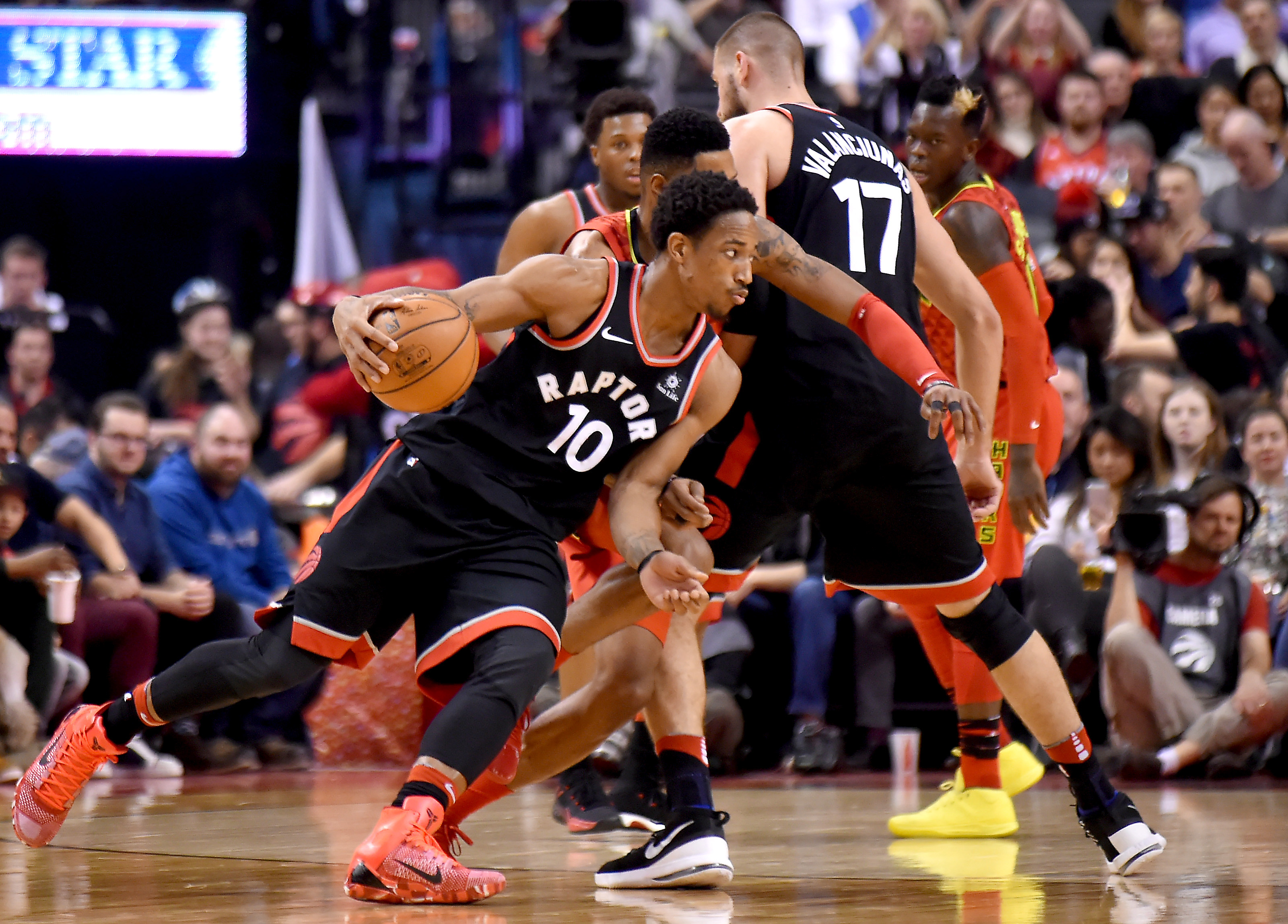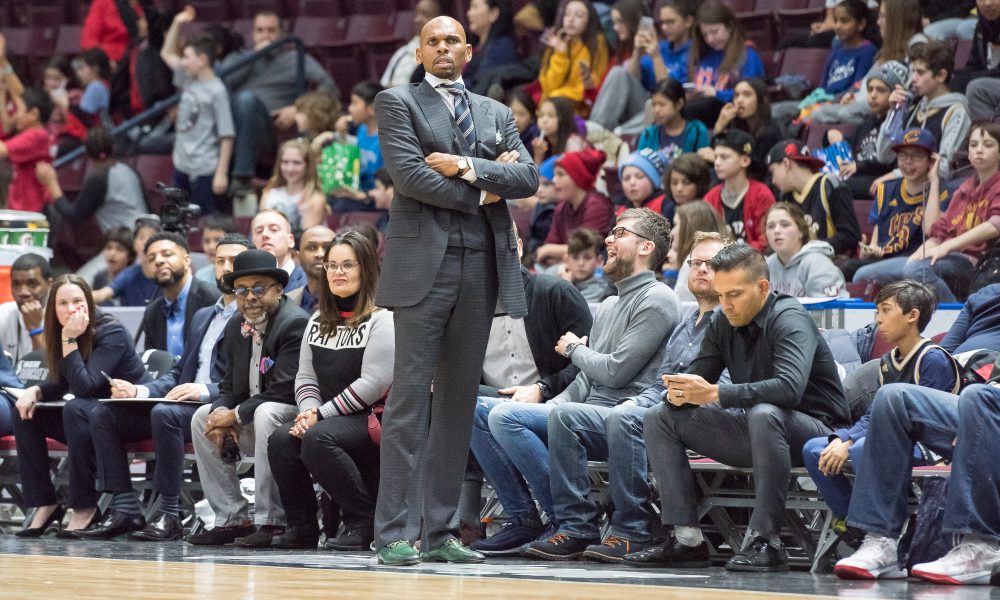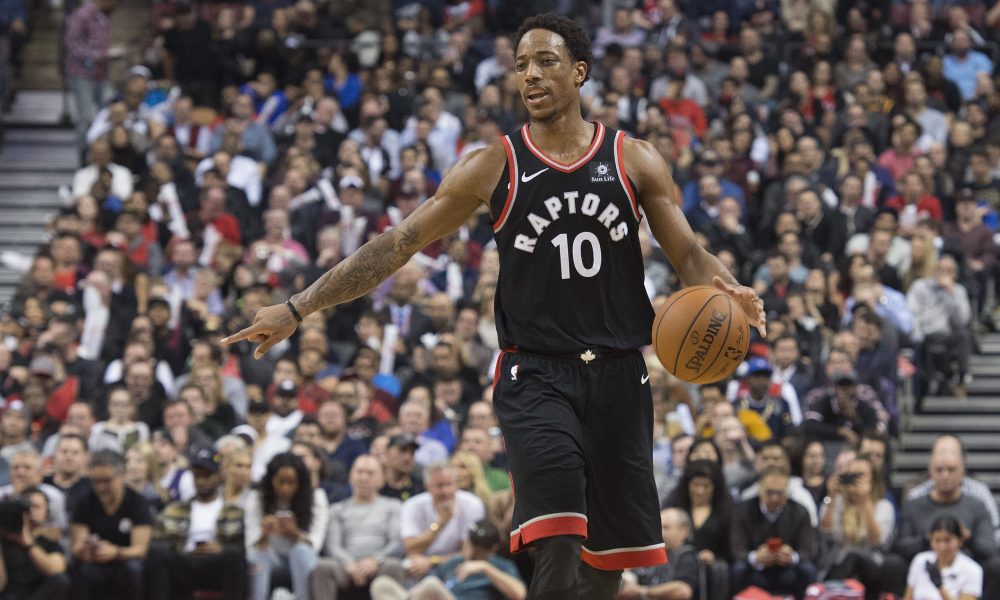The pick and roll remains a significant portion of the 2017-18 Raptors’ offence. DeMar DeRozan ran the 5th-most pick and roll possessions in 2016-17; he’s up to 4th-most this year. It makes sense on a number of levels that the Raptors rely on such a play. First, it’s an easy play to run, often resulting in an efficient shot in a modern NBA offence (read: surrounded by shooting). Whether accompanied by complex off-ball action, preceded by a motion offence, or existing simply in a vacuum, the pick and roll is a staple action in the NBA. Second, the Raptors have a roster very talented at the pick and roll: foot, meet slipper.
| DeMar DeRozan | Delon Wright | Jonas Valanciunas | Lucas Nogueira | Jakob Poeltl | |
| Points per Possession PNR Handler | 0.97 | 1.09 | – | – | – |
| Points per Possession PNR Screener | – | – | 1.12 | 1.53 | 1.21 |
| Total Possessions Used | 442 | 92 | 118 | 30 | 68 |
| Percentile Rank | 84.5 | 93.5 | 56.3 | 96.9 | 73.8 |
All stats taken from Synergy Stats
It’s worth noting that despite being statistically the team’s best pick and roll handler, Delon Wright is only fourth on the team in terms of possessions used. Both Kyle Lowry (195 possessions at a middling 0.88 ppp) and Fred VanVleet (123 at 0.80 ppp) have spent more time handling in the PnR, and even Norman Powell (84 at a horrible 0.67 ppp) has had almost as many. Delon’s usage should increase.
Similarly, Serge Ibaka is the 2nd the most common screen-setter on the team (113 possessions used). He only boasts a sub-50 percentile 1.05 ppp out of the play, largely due to his tendency to pop for contested jumpshots. He refuses to make contact like the Russians with the Grande Armée (boom: history joke). Don’t yet be overly concerned by the high usage in the pick and roll for some of the team’s less effective players; the regular season is for experimentation, finding out what works and what doesn’t. It’s worth mentioning that Kyle Lowry is one of the team’s most intriguing screeners, and the team records 1.20 ppp when he’s used in the role. This rarely happens, but his elite catch-and-shoot ability (shooting 38.8% on catch-and-shoot 3s) immediately warps the defence when he’s the screener. This will happen more in the playoffs.
The Raptors’ offence is elite when one of its elite pick and roll handlers plays with one of its best pick and roll screeners (no surprises there). In the 368 possessions in which Delon Wright has played with one of Jonas Valanciunas, Jakob Poeltl, or Lucas Nogueira, the team’s offensive rating is 119.8 points per 100 possessions. DeMar DeRozan’s 1128 possessions with one of the three centers has yielded 119.0 points per 100 possessions. This is not a small sample size. The league leader in full game offensive rating per 100 possessions is Golden State, at 115.0. The Raptors boast a deadly weapon useable by their starting lineup (DeRozan-Valanciunas) or their bench lineups (Wright-Poeltl / -Nogueira).
If you do want a small sample size goody, Delon Wright and Lucas Nogueira have played together all season for only 75 possessions. They have put up a historic offence of 137.3 points per 100 possessions, per Cleaning the Glass.
This is from early November (I told you, they don’t get many minutes together). Here, DeRozan rockets off of a Siakam screen, which bends a typically-strong Jazz defence. Rubio cheats towards the side action, so Wright drives right, keeping Rubio on his left hip. A Bebe screen levels Rubio, pushing him back further, onto Wright’s back. Wright is so big and strong that he can keep Rubio behind him while maintaining his balance and attack on the rim. Wright has one man to beat, who is so afraid of Bebe as a lob threat, that Wright is able to score on a simple layup.
Wright is an excellent finisher at the rim, shooting only a fraction of a hair worse than DeRozan, at 62.0%. His talent, combined with Nogueira’s ability to jump really high and be really long, opens up the floor for those who play around them. The defence sucks into the paint, afraid of what the duo might create in the initial probing action. Wright is patient enough to wait until the defence commits to stopping one shot, and then he chooses the shot that is left open. Here, Delon again gets his defender on his back. The big chooses to defend Wright, taking away the layup, so the tagger must sink all the way to the rim to prevent the lob to Bebe. This creates oodles of space for a Norman Powell 3:
When playing without a deadly screening combination, the team often finds itself stuck in the mud on offence, unable to create anything resembling an efficient look in the half-court. The Raptors’ worst stretch against the Warriors on January 13th came in the beginning of the second quarter, when the team lacked an efficient pick and roll handler. Its lineup of VanVleet, Norman Powell, C.J. Miles, Pascal Siakam, and Jakob Poeltl struggled to even communicate on offence, let alone put the ball in the hole.
Here the team does run a pick and roll, but VanVleet offers little threat as the handler. He won’t pull up from 3 if you lay off, and he can’t consistently drive past a switching big and finish at the rim. The defence is so little compromised by the initial action that when the ball finds Miles in the corner – usually easy money – Andre Igoudala is so close to Miles that he can’t shoot. Instead he runs his own semi-pick and roll, in the form of a handoff, and his feeble drive is blocked, leading to a transition the other way.
Pick and rolls – like most offences – only create efficient shots if the players running the action are talented at their roles. Fred VanVleet is a superhero, for sure, bordering on a minor deity, but he is probably not the best option to initiate the Raptors’ offence. He has many uses in a successful NBA offence (shooting off the ball, running in transition, providing a capable decision-maker as an outlet after a trap, etc.), but handling in the pick and roll is not yet one of his specialities. As a sidebar, he’s very young, and I believe firmly that this skill will develop, though perhaps not this season.
Similarly, a pick and roll is ruined if the screener fails to threaten the defence. Here, Pascal Siakam sets a screen (I think?) for Norman Powell, but he fails to make contact and then fades to the 3-point line. Similarly, Serge Ibaka is an excellent 3-point shooter, but he fails to make contact so often (like that friend who always ghosts you on weekends), that even his shot-making is unable to bend the defence enough to create an efficient look. Pascal Siakam is…not an excellent 3-point shooter. He’s gotta hit someone on those screens (to be fair, Norm does him no favours with the high, looping angle he chooses to use in his attack).
The action forces the defence to make 0 decisions. Norm is left dancing on his own, with defenders lurking in the background if he chooses to drive. Obviously, he jacks a contested 2 with a foot on the line, because Norm.
Here, a DeMar DeRozan–Jonas Valanciunas pick and roll shows how even a pick and roll that grows from humble beginnings can make something of itself (metaphor for DeRozan himself, perhaps? I’m definitely reaching…). Jonas Valanciunas takes a bad angle for his screen, but he always (always!) makes contact, even grabbing Klay Thompson’s arm a tiny bit to slow him down. DeRozan only needs that sliver of space to gain a runway, accelerating towards the rim, where he finishes incredibly while absorbing contact; DeMar is shooting 64.9% at the rim on the season, despite frequently attempting his layups with defenders draped over his body.
The Raptors’ screening trio of Poeltl, Valanciunas, and Bebe each average more than 4.0 screen assists per 36 minutes: a very good mark comparable to DeAndre Jordan (4.2), Nikola Jokic (4.1), or Marc Gasol (4.0). They set good screen. Poeltl offers textbook examples of how to perform as a rolling big man.
His greatest abilities lie in making contact, and then staying aware of passing lanes, always keeping open an angle for the screener to dish him the ball. He must have learned this from Valanciunas, who possesses similarly excellent rolling awareness. Poeltl has soft hands around the rim, as he easily catches and finishes tough passes. Here he makes the non-traditional pick and roll handler Miles look like James Harden:
A diversified offence is good and important, but it comes at a cost. At the risk of stating the obvious (Imma do it anyway), every shot taken on the basketball court has an opportunity cost: another play could have resulted in a different shot. Put differently, every C.J. Miles above-the-break 3 could be replaced by a Wright-Bebe pick and roll. And those work well.
There will always be a good shot coming out of that action. For the Raptors, a diversified offence has frequently come at the cost of an efficient offence, for stretches of minutes at a time. This has not gone unnoticed. Raptors Republic’s own Anthony Doyle has frequently taken to Twitter to lament the Raptors going away from the oft-successful pick and roll.
There are only two things working for the Raptors on offense tonight:
DeMar and the pick and roll. They've now played 3 straight minutes without a pick and roll big man.
— Anthony Doyle (@Anthonysmdoyle) January 15, 2018
The lineup that is used most often that doesn’t feature an elite pick and roll handler or screener features Serge Ibaka at center. That lineup has had excellent overall success, but there are major issues if you dig deeper. It has put up better numbers against bad teams than good ones. Ibaka-at-center lineups have fared poorly against the Warriors (-13 in 2 games), Thunder (-5), and Spurs (-7), for example. Against all teams, Ibaka-at-center lineups are horrible on the glass, letting opposing teams rebound almost one-third of their misses on the offensive glass (3rd percentile), per Cleaning the Glass. On the offensive end, without an elite pick and roll to fall back on, those lineups have offered a meagre 48.9 eFG%, good for 9th percentile league-wide. Ibaka-at-center has struggled, despite overall positive numbers.
The bet that Casey is making, which is a safe one, is that only a strong spread pick and roll is not enough to win in the playoffs. The team needs more weapons. Fair. Coop recently wrote a fantastic piece, which concludes with some important info: the most successful pick and rolls can come at the end of long series of actions, as “the defense has had to run ragged through 2-3 strenuous actions before this final point has occurred. While a defense might be able to fundamentally defend a handful of actions correctly, bending this much without breaking is a difficult task for 5 players when the offense just needs one misstep to score.” It’s good for the Raptors’ offence in general, but also for the pick and roll specifically, to install other sets and offences. But come playoff time, hopefully the players involved most often in the pick and roll are the ones who offer the most value to the play.



